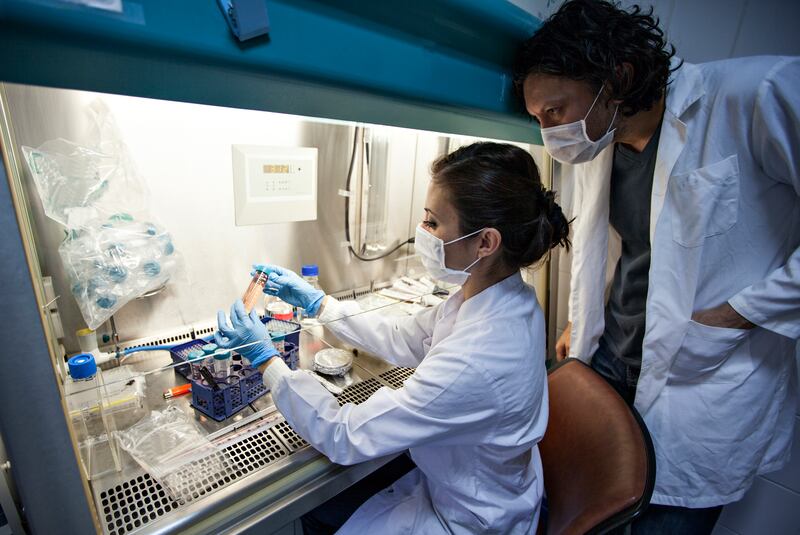The pace of change in business is such that anyone focused on Industry 4.0, the term coined for the new generation of smart, automated and data-driven operations, is already at risk of being left behind. For Accenture it's all about Industry X.O, a customer-centric, data -driven approach that uses advanced technologies to deliver hyper-personalised experiences, products and services.
The global consulting firm, which has grown its staff footprint in Ireland to over 3,500, is particularly attuned to the challenges and opportunities likely to open up in the life sciences sector in the coming years.

Among the biggest of these is what it calls “compressive disruption”, says Barry Heavey, Accenture’s Life Sciences lead in Ireland, whose wealth of experience includes both pharmaceuticals, biopharmaceuticals and medical devices.
Just as retail globally has been disrupted by Amazon, and transport by Uber, the life sciences sector is facing its own paradigm shift.
It’s an industry where high research and development costs, regulation and the long path to commercialisation have traditionally acted as barriers to rapid change.
Expecting change
New research from Accenture titled "New Science – Biopharma's New Growth Machine" indicates this is about to change. "Some of the big pharma companies are already showing signs of coming under pressure from long-term disruption," says Heavey.
The valuation of future earnings is susceptible to change. Investors are worried that some companies’ potential future earnings growth may be challenged in unprecedented ways.
Ireland has seen €10 billion worth of investment by the pharma sector in the past five years alone
Accenture’s research data indicates "future value" in the sector has dropped from 41 per cent of the value of a company in 2014, to 28 per cent in 2018.
“That 13 per cent drop suggests investor worry around pharma companies’ ability to maintain their prices, or their dominant positions as the ‘go to’ treatment provider for a particular disease for as long as they held it in the past,” says Heavey.“There are a few things causing concern right now. Back in 2001 a pharma company could expect that if they launched a leading drug they could retain that position for up to 10 years. That tenure has already fallen to five years.”
No longer being able to rely on just one “cash cow” successful drug puts pressure on them to replenish sales pipelines quickly. But existing manufacturing models struggle to support this – having traditionally supplied a low mix of products in high volume, now they need to gear up for lower volumes and a higher mix of products.
Increasingly, the sector will focus on highly targeted niche treatments. So, instead of one cholesterol blockbuster drug, for example, it will likely seek to develop several different types of drugs which are more targeted by more precise understanding of the disease.
Each of these treatments will, by their nature, only be suited to much smaller patient populations. So, as R&D costs increase, the target markets for each product shrink. “It’s another headwind facing drugs companies,” says Heavey.
How they respond is of particular importance to Ireland. The sector employs 30,000 people directly here, and another 30,000 indirectly through suppliers. The country has seen €10 billion worth of investment by the pharma sector in the past five years alone. If it sneezes, the economy catches a cold.
Resilience
So what is the prognosis? Previous shocks to the sector, such as the "patent cliff" of a decade ago - when many blockbuster drugs manufactured here came off patent, giving rise to competition from generics - was much feared. Though sales and exports fell for a period, the drop-off wasn't as much as expected, and the bounce back has been robust, which suggests resilience.

The fact that the sector had a strong replenishment pipeline at the time helped, says Heavey, as did the advent of a number of new companies to these shores.
“Since then the Irish sector has had a good 10 years, with new manufacturers arriving and a lot of new, and more complex, drugs. The facilities we have here now are much more agile and can make a greater variety of drugs.” However, Accenture’s research has shown that there has been a 61per cent decrease in the three-year average pipeline replenishment ration between 2012 and 2018, another indicator of a wave of compressive disruption on the horizon.
Accenture’s research indicates that the pharma companies which investors are most enthused about today are those embracing what it calls "new science". These are using the powers enabled by the genomic and digital technology/data analytics to create personalised medicine. Accenture predicts that those which embrace "new science" will see sales grow significantly, even in the next three years.
“There is a very deep understanding emerging of the biology of both disease and of patients, which is enabling the sector to come up with very complex, and very effective, treatments.
These treatments are more targeted and more complex. “The challenge with that is that they are also more expensive to manufacture,” he says.
It helps that regulators are responding by moving to approve drugs more quickly. Where before it took 10 years to get from bench to patient, it can now take just half that. This provides the “upside” for pharma companies embracing new science – smaller patient populations, more complexity, but a faster innovation cycle where a company can see shorter timeframe to approval and cashflow or faster failure (and less lost investment) in drugs that will not work.
Combine & Conquer
Accenture’s research indicates that companies are also increasingly combining drug development with the mechanisms used to administer it, from inhalers and injectors to app-based devices. “It’s combining therapy with treatment and placing more emphasis on the experience of the patient or healthcare professional,” says Heavey.
For a sector that has traditionally been able to manage lead times of up to a decade, perhaps the biggest disruption of all, in the old-fashioned sense, is in relation to supply chain management.
They must be not only the best at patient treatment but the production and quality control of their products must be flawless too
The opportunities that lie ahead for the drug companies that embrace new science will only be realised if they embrace new ways of doing things too. This means not just agile and lean but automated, digital and data-driven.
“We see a really big opportunity for companies to embrace these new treatments but they also need to embrace the new manufacturing,” says Heavey.
“They must be not only the best at patient treatment but the production and quality control of their products must be flawless too.”
Enterprise Systems Partners

It is this emerging need that drove Accenture's recent acquisition of Cork-based life sciences company, Enterprise Systems Partners (ESP).
A highly successful life sciences specialist firm founded in 2003, ESP provides consulting and support services for manufacturing operations in biotechnology, pharmaceutical and medical devices. In particular, it digitally tracks and documents the bio-pharmaceutical production process, leading to increased automation in the supply chain.
One measure of its success is the fact that ESP currently services 17 of the top 20 global pharmaceutical and biotech companies. It employs 100 people in Cork plus another 100 in markets including the US , the Netherlands and Turkey.

“The advent of ‘new science’ to create personalised medicine is leading not just to increasingly complex drugs but to increasingly complex drug manufacturing, at a reduced development cycle. This puts increasing pressure on manufacturing and supply chain generally. The only real response is digitisation and control, to give you the flexibility and agility you need to cope,” says Liam O'Brien, ESP managing director.
It’s amazing now that the world’s best-known blockbuster drugs “were produced on paper-based systems,” he says.
The future is digital. It will see a mix of new technologies from the Internet of Things and data analytics to artificial intelligence, robotics, and 3D printing. In other words, for the personalised medicines that new science is helping create, a new manufacturing prescription is required: Industry X.O. The large installed base of biopharma manufacturing and R&D in Ireland, together with the well-developed support ecosystem, means we are well placed to develop a global leading digital environment for the development and manufacture of these ‘new science’ drugs.
Outlook for the Irish sector
In the face of the compressive disruption facing the pharma industry globally, Ireland could be susceptible to another “patent cliff or patent slope”. Ensuring sites here are well positioned for the increased pace of change and complexity coming from new sciences will be key. Investment in digitalisation in pharma manufacturing, quality control and supply chain can help the sector cope with the shortened lead times, cost pressure and increasing complexity and mix of treatments in their portfolio. If the Irish life sciences sector can use these digital tools to retain its reputation for agility and flawless execution in supply chain, it can ensure it is well positioned for the upside from disruption.
[ accenture.com/ie-en/services/industryx0-indexOpens in new window ]
This article makes descriptive reference to trademarks that may be owned by others. The use of such trademarks herein is not an assertion of ownership of such trademarks by Accenture and is not intended to represent or imply the existence of an association between Accenture and the lawful owners of such trademarks.










